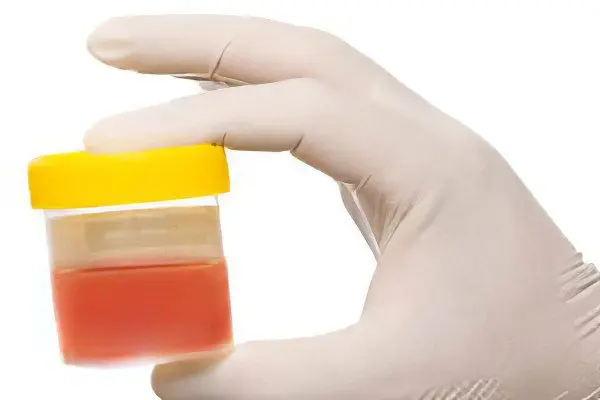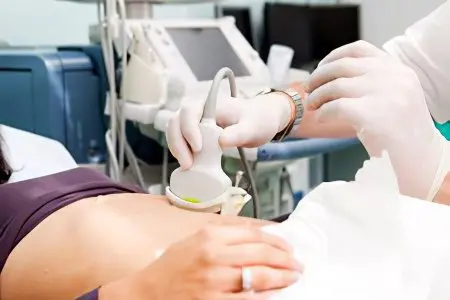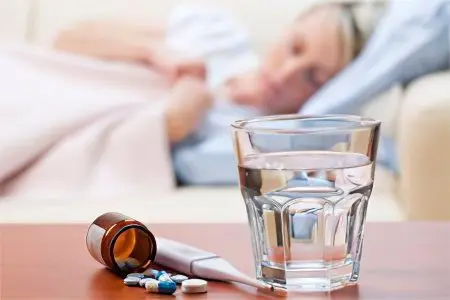Contents
- What is cystitis?
- Symptoms of cystitis in women
- Causes of cystitis in women
- Complications and consequences of cystitis
- Diagnosis of cystitis
- How to relieve an attack of cystitis? First aid at home
- How to treat cystitis in women?
- Prevention of cystitis – useful tips for women
- Answers to popular questions
- Which doctor should I contact for cystitis?
- Is it possible to have sex with cystitis? Is it sexually transmitted?
- Cystitis after intimacy, what are the causes?
- Is it possible to play sports with cystitis?
- Is it possible to take a hot bath with cystitis?
- Can there be a delay in menstruation with cystitis?
What is cystitis?

Cystitis is one of the most common diseases of the genitourinary system. During the pathological process, for one reason or another (infectious agents, chemical and traumatic injuries), inflammation of the bladder mucosa occurs.
Cystitis is considered a typical female disease. According to medical statistics, 80% of all cases of cystitis are women. This is understandable from an anatomical point of view: the urinary tract in women is much shorter than in men, which means that pathogens (which are mostly the causative agents of cystitis) meet less resistance and make a quick way to the bladder. That is why women should empty their bladders more often, and if urinary retention occurs, the risk of developing cystitis increases significantly.
Cystitis affects not only the mucous membrane of the bladder. In general, this is a rather complex disease, entailing a lot of complications and discomfort.
Symptoms, diagnosis and treatment strategy depend on many factors:
The nature of the pathological process;
Localization of inflammation;
Exciter type.
Cystitis is divided into types according to several criteria:
Based on the type of pathogen: bacterial cystitis (chlamydia, ureaplasma, gonorrhea, other pathogens of sexually transmitted diseases, as well as staphylococci, streptococci, E. coli, and others) and non-bacterial cystitis (toxic, caused by medication, allergies);
By the nature of the course of the disease: acute cystitis (occurring in the acute phase with the manifestation of typical symptoms) and chronic (occurring in a latent form or recurrent);
Depending on the presence and type of organic (morphological) changes in the organ: ulcerative, catarrhal, cystic, etc.;
Based on the localization of the pathological process: cystitis of the bladder mucosa, affecting the submucosal layer, affecting the muscular layer.
Symptoms of cystitis in women
Cysts hurt
The nature and intensity of pain and discomfort during cystitis are purely individual and depend on the pain threshold, as well as on the degree of damage to the bladder structures themselves.
Not all people and not always experience intense pain (cutting, burning) with this pathology. In some cases, the disease can manifest itself only with mild discomfort in the lower abdomen and pubic area (heaviness, feeling of fullness). According to statistics, in this form, acute cystitis occurs in no more than 10% of women (more often “imperceptibly” the pathology passes in men). In most of the fair sex, the disease is accompanied by intense pain, which is understandable: the woman’s urethra is much wider and shorter, and this, as already mentioned, is a direct gateway to infection.
It is generally accepted that with cystitis, pain is localized only in the area of the bladder. This is not entirely true. Often the pain can be radiating (wandering) in nature. Pain from cystitis passes into the lumbosacral spine and patients feel as if their back hurts.
Pain syndrome can also be localized in the coccyx. Radiating pain can be pulling, aching or dull, independent of the intensity of physical activity, or cutting and burning. Especially brightly the pain syndrome is shown at an urination. The patient is “haunted” by a feeling of fullness of the bladder, when urinating, there is severe pain in the urethra, bladder and back.
Pain is often accompanied by general symptoms of intoxication of the body: headache of varying intensity (localized in the forehead), weakness and fatigue, hyperthermia (fever) up to 37,5 – 38 ° C. Pain and manifestations of intoxication are considered as a single symptom of pathology and are inseparable from each other, although with a weakened immune system, there may be no hyperthermia.
Cystitis with blood in women

In some cases, women with cystitis may notice that the urine has a pale pink or intense red tint. There can be two reasons for this: either we are talking about acute cystitis, or about its much more severe form – hemorrhagic cystitis. It is relatively easy to distinguish them, with an acute form, the urine acquires a reddish tint at the end of urination, with complicated cystitis, the urine is red throughout the act and retains its hue during all subsequent trips to the toilet.
The most common cause of blood in the urine is a viral lesion of the bladder mucosa (the main causative agent in this case is adenovirus). In women, hemorrhagic cystitis is relatively rare, because with frequent urination, viruses and their metabolic products are quickly excreted from the body, not having time to lead to the development of tissue degeneration.
However, not in all cases, the cause lies in the infection, similar forms of cystitis are caused by taking cytostatic drugs, radiation (radiation) injury (for example, with specific therapy for malignant neoplasms).
Also among the causes of cystitis:
Injury to the walls of the bladder and urethra with foreign objects;
Lack of muscle tone of the bladder;
Congestion in the bladder, leading to the development of degenerative changes;
Violations of the anatomical nature (stenosis of the lumen of the urinary canal, compression of the structures of the excretory system by an oncological neoplasm).
Therefore, most often cystitis with blood in women is a secondary pathology caused by certain factors.
Acute cystitis with blood and, moreover, hemorrhagic is severe:
There are intense pains that are permanent, persistent.
Frequent false urge to urinate;
The main manifestation of such forms of the disease is the allocation of blood. Despite the fact that the blood begins to come out only a few hours after the onset of the acute phase, the intensity of bleeding can be so high that the blood, under the influence of specific substances that make up the urine, will clot, forming large blood clots. Thrombi, clogging the lumen of the urethra, entail a delay in the outflow of urine and, as a result, further complicate the patient’s condition.
Itching and burning with cystitis
Itching and burning are perhaps the most common symptoms of cystitis in women after the pain syndrome. Usually both of these manifestations are observed in the allergic or infectious nature of the disease.
Often cystitis in women is associated with inflammatory lesions of the genital organs. One may be in a causal relationship with the other (for example, often with diseases of the vagina, colpitis, infectious agents can penetrate into the urethra due to its anatomical proximity and affect the bladder, as well as vice versa: an infection from the bladder with urine leaves the body and, getting on the external genital organs, entails secondary colpitis).
Itching and burning also often occur with an allergic origin of cystitis. The allergen is recognized by the patient’s immune system as an antigen, as a result of which the immune system produces specific antibodies to fight the “dangerous intruder”. As a result of the reaction, the antigen-antibody complex settles on mast cells (basophils) located in the urethra and urethra. Under the influence of the complex, basophils are destroyed, releasing large amounts of the substance histamine, which is an itch mediator (ie, a substance that irritates the epidermal nerve endings) and causes an unbearable sensation of itching and burning.
For similar reasons, itching and burning are also observed in inflammatory lesions: infectious agents and toxic products of their vital activity (with a bacterial origin of the disease) or specific substances contained in drugs accumulate in large quantities in the urine. Exiting, these substances act on superficial nerve endings.
In general, such a symptom as itching with a 95% probability indicates an allergic or infectious nature of cystitis, which means that concomitant lesions of the vaginal mucosa are possible.
Could there be a temperature for cystitis?
To correctly answer the question, it is necessary to understand why the body temperature rises. Hyperthermia occurs as a result of an acute immune reaction to a substance or microorganism of foreign origin. At temperatures above 37 ° C, pathogens lose their previous activity, and the intensity of their vital activity decreases sharply. Almost always, infectious cystitis is accompanied by an increase in body temperature ranging from 37,5 to 38,2 ° C. This normal phenomenon indicates a strong immune system that can resist infection. The height of the numbers largely depends on the direct causative agent of the disease.
For this reason, even cystitis of an infectious nature may not cause an increase in temperature. So, for example, the causative agent of tuberculosis in the early stages of the disease does not reveal itself with an increase in temperature, while most sexually transmitted infections and even adenovirus cause significant hyperthermia, up to values of 39 ° C.
An excessively high temperature that threatens the patient’s life with this disease rarely rises. If this happens, then the disease is severe and you should immediately seek emergency medical help. Therefore, cystitis should not be considered such a harmless pathology. It is necessary to carefully monitor the dynamics of body temperature. Otherwise, a huge number of complications may develop, up to the involvement of the kidneys in the pathological process, the occurrence of acute renal failure and death.
Causes of cystitis in women

As noted earlier, the disease in the vast majority of cases develops in women, which is due to the short and wide urethral canal, the close location of the anus and vagina (as is known, even the conditionally pathogenic microflora of the mucous membranes of the colon and vagina can cause the development of inflammation of the bladder, often it also happens that pathogenic microorganisms live on the mucous membranes, which do not manifest themselves until a certain point).
In 85-90% of cases, cystitis in women develops precisely because of the penetration of a pathogenic or opportunistic microorganism (infectious cystitis). Not always the pathogen enters the bladder from the vagina or anus.
Ways of penetration can be different:
Downward path. The infection can spread from the kidneys to the bladder;
Ascending path. What has already been named – from the outside through the urethra to the bladder;
hematogenous route. It is relatively rare for a bacterium or virus to enter the bladder through the blood stream. The cause can be any focus of an infectious lesion in the body, however, the chance that a disease-causing agent will get, for example, from the tonsils into the bladder, is extremely small, but still there.
lymphatic pathway. The pathogen enters the bladder from the pelvic organs that have undergone inflammation.
However, in addition to infectious origin, cystitis can develop due to:
Taking certain medicines. Among these, for example, cytostatic drugs used to combat malignant neoplasms. During the processing of such substances by the body, the metabolite acrolein is synthesized, which actively irritates the bladder mucosa, thereby causing the development of toxic (drug) cystitis;
Allergic reactions. Allergies are often local in nature. In some cases, the bladder is affected.
Very rarely, cystitis in women occurs in isolation. The reasons themselves for the most part are conducive to the development of a general inflammatory process in the pelvic organs: this is the wearing of tight synthetic underwear, and frequent changes in the sexual partner, and neglect of the rules of intimate hygiene. All this leads to the fact that the woman herself creates favorable conditions for the reproduction of representatives of pathogenic microflora. According to statistics, about 80% of the causative agents of cystitis are Escherichia coli, 10-15% are staphylococcus and about 4-5% are other pathogens, such as Klebsiella, Proteus amoeba, etc.
More: Causes of frequent urination in women ➤
There are several risk factors for developing cystitis:
Inflammation of the vagina (colpitis) and sexually transmitted diseases. With the anatomical proximity of the vagina and urethra, the occurrence of cystitis is only a matter of time;
The same can be said about constipation and other problems with the intestines (colitis, etc.). Microorganisms from the large intestine, also due to the anatomical proximity of the anus and external genital organs, can provoke the formation of an acute form of the disease;
Nephrological diseases: kidney stones, nephritis and pyelonephritis, urinary retention. According to the descending principle, the infection often descends from the kidneys to the bladder, and with stagnation of urine, very serious pathologies and forms of the disease can develop.
Peak hormonal states. Pregnancy, menstrual cycle, menopause, etc. The reason lies in the change in the hormonal background and, as a result, the microflora of the mucous membranes of the vagina and urethra;
Among the predisposing factors are also endocrine diseases, especially diabetes mellitus;
The risk group includes allergy sufferers, as well as cancer patients undergoing chemotherapy.
Regardless of the causes and source of the disease, cystitis includes a characteristic symptomatic complex:
Frequent and painful urination. Burning, drawing pains in bladder and urethra;
The urge to urinate may be false;
Urinary incontinence (sometimes);
Increased urge at night without increased production of urine.
Constant pain in the pubis and perineum, radiating to the lower back and coccyx. Pronounced pain at the beginning and end of the act of urination;
Dark color of urine, or cloudy, with impurities of pus;
General manifestations of intoxication.
If the cause lies in allergies, the development of excruciating itching and burning in the urethra is possible.
Complications and consequences of cystitis

Cystitis is by no means a harmless disease, and the principles of “drink something” and “it will pass by itself” do not work here.
If the course of necessary treatment is not carried out in time, the consequences can be more than disastrous:
On the ascending path, kidney damage occurs. According to medical statistics, in 95% of cases, untreated cystitis causes severe kidney disease: pyelonephritis, nephritis. The most formidable consequence is renal failure, which is formed due to excessive poisoning of the tissues of the paired organ with the waste products of the infectious agent;
Women may suffer from the return of urine from the bladder back to the kidneys. This happens extremely rarely. More often, a similar syndrome (vesicoureteral reflux) develops in children;
Prolonged and at the same time ineffective treatment can lead to organic changes in the tissues of the organ. Degeneration of the epithelium occurs and, as a result, the bladder loses its elasticity, loses its ability to regenerate, and decreases in size. A similar consequence makes a person hostage to cystitis and increases the risk of bladder rupture;
If specific treatment is not carried out in a timely manner, the risk of the disease becoming chronic is high. Chronic cystitis, especially infectious (and most often it happens) is a source of constant inflammation. As observations show, cystitis is almost never an isolated pathology. Nearby organs are most commonly affected. Therefore, women suffering from chronic cystitis are at risk of becoming infertile: with relapses of the disease, an exacerbation of colpitis develops, followed by the formation of adhesions in the structures of the uterus. Thus, cystitis indirectly contributes to a decrease in reproductive function up to its absolute loss;
Although it is difficult to call stress and depression the direct complications of cystitis, they are. If the pathology is not cured in time, it becomes chronic. Relapses of the disease are frequent, and can occur almost several times a month. The disease exerts the strongest psychological pressure on a person, literally making a healthy member of society a hostage of the toilet. In addition, a dominant is formed in the human mind;
Weakening of the sphincter of the bladder. May lead to urinary incontinence. Most often, it develops in older people.
Diagnosis of cystitis

Primary diagnostics includes face-to-face examination by specialized specialists: urologist, nephrologist, gynecologist.
Specialists are engaged in the collection of anamnesis and determine the possible causes of the onset of the disease.
When collecting an anamnesis, doctors are especially attentive to risk factors:
unprotected sexual intercourse;
Hypothermia;
Excessive emotional stress;
Medications taken;
The presence of concomitant diseases and pathologies (in the pelvic organs in the first place).
Laboratory research
Include:
Delivery of a general blood test. In general, according to the results, a picture of the inflammatory process develops, an increase in ESR, leukocytosis is possible. However, changes in the blood may not be at all. A general blood test shows whether there are more dangerous diseases that “masquerade” as cystitis: oncology, etc .;
Delivery of a general urine test. In the urine, erythrocytes, leukocytes, protein are found, the urine itself is cloudy, it may be mixed with blood or pus. In the hemorrhagic form of the disease, the urine is pink;
The delivery of a urine test for crops according to Nechiporenko. Helps to identify the causative agent of the disease.
Among the instrumental methods, two main ones are used:
Ureteroscopy and cystoscopy. Endoscopic examinations are aimed at visual examination of the condition of the mucous membranes of the urethra and bladder. Despite the discomfort during these procedures, their information content is extremely high.
Ultrasound examination of the bladder. Allows you to determine the organic changes on the part of the body.
How to relieve an attack of cystitis? First aid at home
Attacks of acute cystitis are extremely painful for patients. The intensity of pain and discomfort can be very high. The first and foremost way to relieve an acute attack of cystitis is to consume as much liquid as possible. Many believe that with cystitis you need to drink less water, then the pain and other manifestations will go away. This is a fundamental misunderstanding of the problem. Without enough water, an attack can drag on for a long time. Due to increased fluid intake, foreign substances and microorganisms are quickly evacuated from the body, and pain relief occurs.
In severe cases, it is recommended to resort to medical assistance:
The best solution would be to take antispasmodics. They eliminate spasms and help reduce the tone of the smooth muscles of the bladder: No-shpa, Spasmalgon, Papaverine, etc .;
In addition to antispasmodics, pain is relieved by analgesics (which reduce the conductivity of nerve endings). Analgin, Ketorol and others;
You should never take antibiotics on your own. Taking antibiotics is guaranteed to lead to a change in the picture of laboratory tests, and the specialist will not be able to establish the source and cause of the disease. Such measures are also fraught with insufficient impact on the source of the problem. By self-medication, the patient can only drown out the disease and remove the symptoms, but the disease will become chronic;
If the diagnosis is confirmed and already known to the patient, you can resort to taking antibacterial drugs. Among the effective drugs are Nolicin, Furadonin, Monural. Furadonin is at the same time a powerful diuretic, therefore, it is recommended to combine the intake of these drugs with increased fluid intake (it is better to stop at plain clean non-carbonated water).
In all other cases, it is better not to self-medicate. Attacks of complicated cystitis (with blood, hemorrhagic, etc.) are removed exclusively in a hospital. Otherwise, life-threatening bleeding may develop.
How to treat cystitis in women?

The treatment of cystitis is a responsible event that requires the efforts of several specialists at once: a urologist, a gynecologist, a nephrologist. With proper therapy, a complete cure for cystitis occurs after 7-12 days from the start of treatment.
Since most often cystitis in women develops due to an infectious lesion, specific therapy is aimed at destroying pathogens.
Means for the regeneration of the bladder mucosa. One of the new terms in the treatment of chronic cystitis is glycosaminoglycan. Therapy with its use refers to replacement. A healthy bladder has a protective layer on the inside; it is a membrane that protects the walls of the bladder from contact with urine and the bacteria in it. Glycosaminoglycans (including the well-known hyaluronic acid), as well as chondroitin sulfate, form this shell. And its destruction due to various factors is one of the causes of cystitis. Therefore, the introduction of protective layer components into the bladder will help regenerate the membrane and restore its protective properties. These drugs include: Monurel, Urolife, Urogial.
Antibiotics. In recent years, drugs from the group of fluoroquinolones, for example, ciprofloxacin (Tsiprolet A, Tsifran), and nitrofurans (Furadonin), and other antibiotics for cystitis, have proven their effectiveness. Taking these drugs is possible only for the direct appointment of a specialist;
If specific pathogens are identified according to the diagnostic results, appropriate antifungal, antimicrobial or antiviral drugs are prescribed;
Anti-inflammatory drugs. They are necessary to fight cystitis, since it is an inflammatory disease. The most effective is Ibuprofen, which can be found in pharmacies under various trade names: Nurofen, Ibuklin, Mig, Faspik and others;
With severe pain. To eliminate a strong pain syndrome, antispasmodics and analgesics are recommended: No-shpa, Drotaverine, Papaverine, Diclofenac, Nimesil (non-steroidal anti-inflammatory drugs);
Herbal preparations. It is also recommended to take herbal preparations for cystitis: Canephron, Cyston, Fitolizin, Monurel (cranberry-based drug);
Herbs. In the absence of allergies to medicinal herbs, it is allowed to take herbal teas based on lingonberries, horsetail, bearberry. Preference should be given to unpackaged products;
Probiotics. It is used to normalize the microflora of the vagina and intestines, since it is these infections that are often the root cause of cystitis. For this, drugs with lacto- and bifidobacteria are effective: RioFlora Balance, Bifiform, Hilak Forte, Acipol, RioFlora Immuno. Taking probiotics will help to avoid recurrence and cope with the chronic form of cystitis.
Water. To quickly remove toxins from the body, it is recommended to increase the daily volume of fluid intake.
All medicines should be taken only as prescribed by a doctor and in the dosage prescribed by him. Remember that overdose of any medicine on the list can be hazardous to health.
Prevention of cystitis – useful tips for women
It is mandatory to follow the rules of personal hygiene. For washing, you need to choose products that are neutral in their acid-base properties. Proper intimate care is the key to the absence of relapses.
It is recommended to empty the bladder as often as possible. Stagnation of urine is fraught with the development of complications.
Hypothermia should not be allowed. Feet must be kept warm and dry.
During the exacerbation of the disease, it is worth increasing the volume of fluid consumed to 2-2,5 liters per day: water, fresh natural juices, cranberry juice. You should refrain from drinking carbonated water and artificial drinks.
As with acute cystitis, and with an exacerbation of chronic, you should stop wearing tight synthetic underwear.
Constipation indirectly affects the risk of developing cystitis. Therefore, prevention measures also include methods to improve intestinal motility.
Answers to popular questions
Which doctor should I contact for cystitis?

First of all, it is necessary to make an accurate diagnosis. A specialist working with problems of the human excretory system is a urologist. With a visit to the urologist, you should start the fight against cystitis. To clarify the diagnosis, the first thing to do is to take a urine test. In most typical cases, this is sufficient. Only a urologist can correctly and unambiguously interpret the results of a laboratory study. In addition, the urologist prescribes urine sampling for bacterial culture according to Nechiporenko, cystoscopy and ultrasound examination of the bladder.
Based on the complexity of cystitis, it is imperative to visit a gynecologist. Often, cystitis in women is provoked by sexually transmitted diseases, but even if the cause is other infectious agents, it is important to exclude colpitis and uterine lesions in order to protect yourself from loss of reproductive function in a timely manner, as well as minimize the risk of developing chronic pathologies of the genital organs.
You should also visit a nephrologist. Kidney diseases, which often appear after suffering cystitis, are the most dangerous for the life and health of the patient. In the early stages of kidney disease may be invisible. This is just an illusion. In fact, there is an active degeneration of the tissues of the kidneys and the loss of the organ of its functions. To protect yourself from the appearance of kidney failure (and therefore from the need for hemodialysis, donor kidney transplantation, death), it is important to plan a trip to the nephrologist as soon as suspicious symptoms are detected.
Thus, you should contact three specialists: a urologist, a nephrologist and a gynecologist.
Is it possible to have sex with cystitis? Is it sexually transmitted?
Cystitis is an inflammatory disease of the bladder. Of course, it is simply impossible to get infected with cystitis through sexual contact.
However, there is a high probability of transmission to the partner of those infectious agents that caused cystitis. But you need to make a reservation, the transmission of pathogenic microflora is possible only if the disease has an infectious origin. In all other cases, the partner is safe.
As for another aspect of this issue, everything is not so clear-cut. Most competent experts recommend that women refrain from sexual activity during the illness.
There are several reasons for this:
During sexual intercourse, pressure can be exerted on the inflamed bladder, and here the consequences are the most unpredictable: from the return of urine back to the kidneys and their subsequent damage to the rupture of the bladder. In addition, an increase in symptoms is guaranteed;
Even if the patient has been treated, the risk of relapse remains;
The most obvious answer to the question asked is that sex during acute cystitis is not a pleasant experience. A woman with a high degree of probability will experience a lot of painful and uncomfortable sensations.
However, if you cannot do without sexual contact, you need to follow the recommendations:
Immediately before sex, wash the body and carefully treat the hands;
Avoid touching the vagina. The mucosa during cystitis is subjected to increased stress, since it is impossible to completely protect it from the ingress of urine particles;
If there is suspicion of concomitant damage to the uterus, exclude deep penetration;
At the end of intimacy, be sure to rinse the external genitalia;
Use barrier contraception (condoms only).
Cystitis after intimacy, what are the causes?

The development of cystitis after sex is not a far-fetched problem. Postcoital cystitis (also called “honeymoon syndrome”) occurs in about 45% of cases. As a rule, it is detected after the first sexual contact.
There are several reasons for this:
The most common, but at the same time the most difficult to eliminate, is a congenital anomaly of the genitourinary system. If injuries were observed in the perineal region, the anomaly may be acquired. It lies in the fact that the opening of the urethra is displaced relative to its normal position down and inward, into the vaginal area. This is a displacement of the urethral canal. Another type of anomaly is also possible, excessive channel mobility. Both pathologies are relatively easy to detect with a digital examination by a gynecologist. As a result, during sexual intercourse, the urethra is actively involved, irritated. The walls of the urethral canal are covered with micro-ruptures and cracks. This is a direct gateway for infection. The damaged mucosa becomes inflamed, and further along the ascending path, the infection penetrates the bladder;
Another common reason is the lack of proper hygiene. The partner may not be aware of this, while there are many microorganisms on the surface of the penis. As a result, the woman’s urethra is attacked by an infectious agent. Also, this group of reasons includes the alternation of vaginal and anal sex without changing the condom or without it at all. In this case, the causative agent of cystitis is the intestinal microflora (rod);
Dryness of the vagina. Due to excessive dryness of the vaginal mucosa, tissue cracking occurs. As a result, colpitis, which quickly provokes the development of the disease. In this case, cystitis becomes a secondary disease. Therefore, you can not have sex in the absence of desire and sufficient hydration of the female genital organs;
It is also worth remembering the pathogens of sexually transmitted diseases. If the partner is sick or is a carrier, the woman quickly becomes infected, and in this case there is a risk of not only developing a sexually transmitted disease directly, but also secondary cystitis.
Is it possible to play sports with cystitis?
In this case, everything is purely individual and depends on the patient’s condition and the severity of the course of cystitis. However, a number of physical activities must be abandoned.
It should be avoided:
Visits to fitness clubs. Aerobics and exercise can lead to mechanical irritation of the urethra and bladder, as a result, the symptoms will worsen significantly;
Swimming. Swimming is allowed, but not longer than 10-20 minutes. Prolonged exposure to cold water (30-50 minutes) is guaranteed to lead to local hypothermia. As a result of cooling, local immunity will decrease, within just a few hours the symptoms of cystitis will become more pronounced. Refusing to swim is recommended not only for women with acute cystitis, but also for those who suffer from a chronic form of the disease. A long swim in the pool is a direct path to relapse. Swimming is allowed without time limits only in pools where the water temperature does not fall below 30-35 °C;
Winter sports. Almost all winter sports involve being out in the cold for a long time. Under such conditions, the risk of developing hypothermia and aggravating the course of the disease increases significantly. People who are keen on figure skating are advised to dress as warmly as possible, cover the pelvis and perineum, and in no case should they sit on the ice;
Exclude active sportsassociated with increased physical activity and a sharp increase in intra-abdominal pressure: boxing, wrestling, cycling, etc.
However, there are a number of sports that are recommended for cystitis. They evenly strain the muscles of the body and do not cause significant fatigue. These are jogging, walking, basketball, volleyball. Dancing is also allowed. It is important to remember that clothing must be appropriate. It is harmful to wear tight tight clothes. A tracksuit should not be tight-fitting, preference should be given to light, but at the same time warm clothing made from natural materials.
Is it possible to take a hot bath with cystitis?

In general, the issue is highly controversial. To answer it, you must again proceed from the patient’s condition at the moment and the course of the disease. You can take warm (warm, but not hot) baths only at the stage when cystitis does not yet make itself felt with specific symptoms. In this case, light warming is not only not contraindicated, but also useful.
As soon as one of the following symptoms appears, thermal procedures are strictly contraindicated:
Muscle spasms (sharp cramping pains in the lower abdomen and pubis);
Burning and pain when urinating;
Blood or pus in the urine.
If warming is continued after acute symptoms have been identified, there is a risk of life-threatening bleeding.
During menstruation or pregnancy complicated by cystitis, hot baths are strictly contraindicated (miscarriage is possible).
If we are talking only about the initial stages of the disease, warming up is allowed, but they should be used only within reasonable limits:
Heating with dry heat. Salt is heated in a bowl to 38-40 ° C, poured into a cloth bag and applied to a sore spot;
Foot baths. The basin is filled with warm water, after which you should take a foot bath for 10-20 minutes. Then the feet are wiped dry and warm socks are put on;
Sitting baths. At the first stages of the development of cystitis, you can take sitz baths with the addition of medicinal herbs. In this case, the water temperature should not be higher than 37 ° C, and the duration of the bath should be up to 10 minutes. Even a warm bath is prohibited in cases where, in addition to the bladder, other organs are affected: kidneys, etc .;
Warm shower. The best way to alleviate cystitis and conduct hygiene procedures during the course of the disease;
Warming up with warm hands. For several hours, a palm is placed in the bladder area;
Warm compress with eucalyptus oil. Effective in the absence of acute symptoms. But it is contraindicated in case of allergies.
Can there be a delay in menstruation with cystitis?
There is no direct causal relationship between cystitis and menstrual irregularities. However, as mentioned earlier, rarely cystitis in women occurs only with damage to the bladder. Rising, the infection often affects the genitals, including the uterus and ovaries located in the abdominal cavity.
The ovaries are responsible for the production of estrogen, a specific female hormone, which itself contributes to the normalization of the menstrual cycle. When the infection spreads to the ovaries, there is a decrease in the intensity of estrogen production. As a result, the cycle is broken, and then a delay in menstruation is possible.









